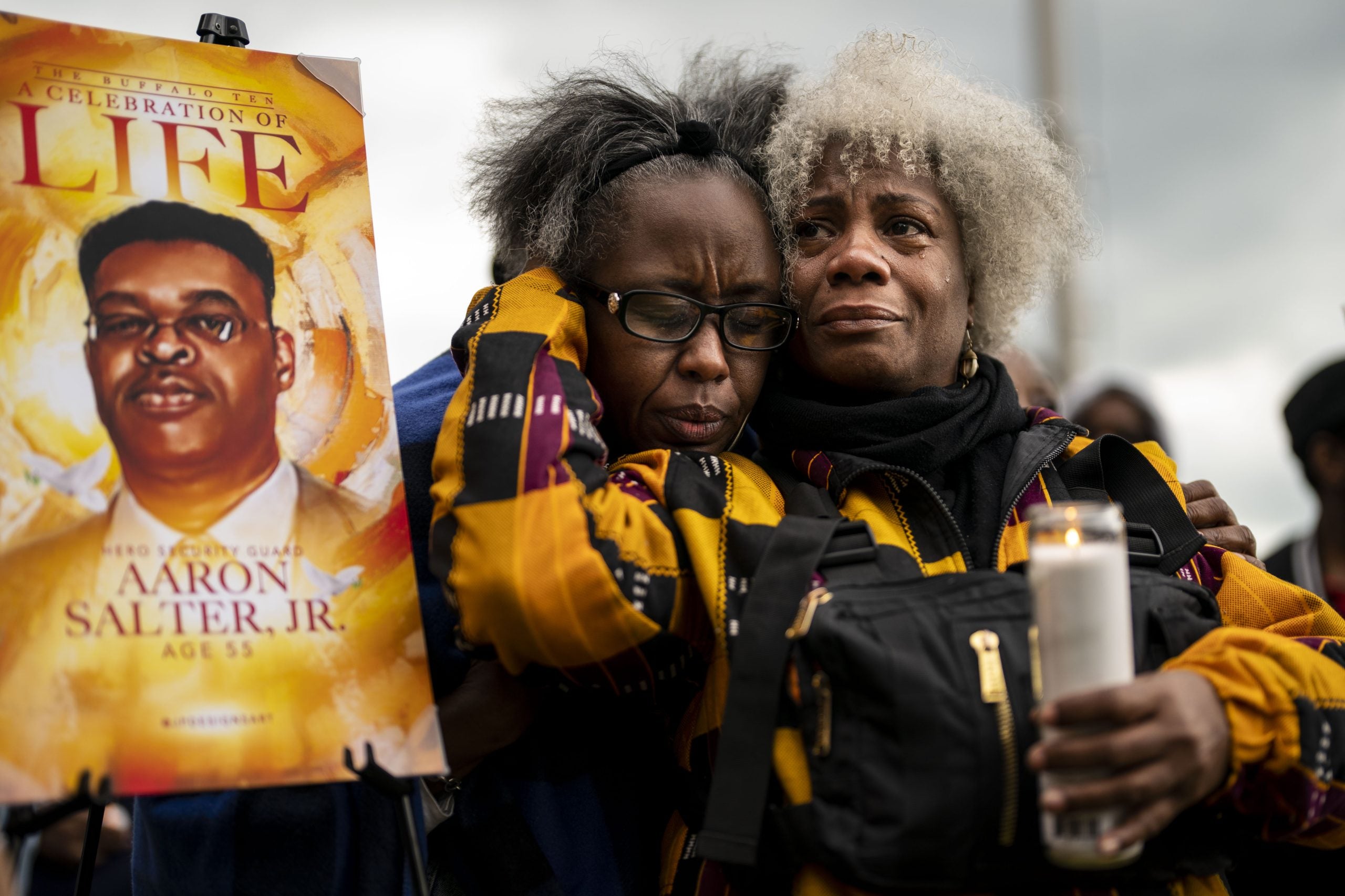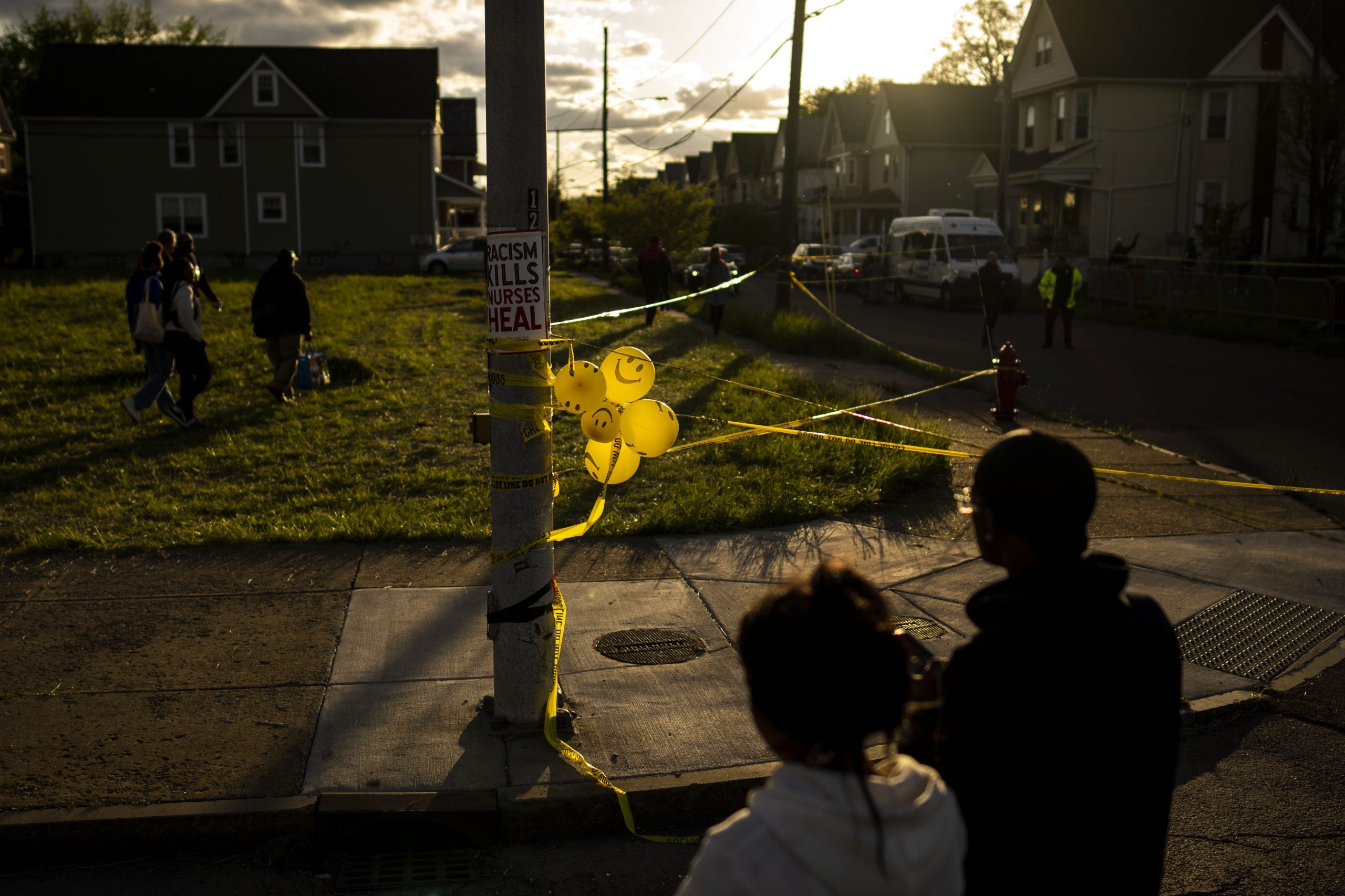
When news of a racially-motivated mass shooting in Buffalo, New York began to surface last weekend, I couldn’t pull myself to look into the heart-wrenching details. Weighed by the total number of lives lost and the adjacency of age that many of the victims were to some of my own closest loved ones, the need to self-preserve took precedence over any desire to seek out further information.
But in reality, you’re never truly ready to hear of such a tragic occurrence, especially when the violence that marked it takes place while doing such a mundane, everyday task like grocery shopping and running errands. Tasks that our elders, of all people, should have the ease and peace of mind to pursue without the fear of being gun downed.
Sadly, a white, 18-year-old male took that peace of mind away from many when he opened fire at a Tops supermarket in a predominantly Black neighborhood, claiming the lives of 10 people.
While anti-Black violence against our community isn’t uncommon, there’s no space for these heinous events to be normalized into our collective consciousness. Still, the nature of the Buffalo shooting registered in my body differently than previous racial attacks have. I found myself going through the motions of life in a daze to protect myself. My breathing was labored and my shoulders were tight with every raw emotion stifled within my chest. I was in survival mode: my body switched into auto-pilot before I could even notice.
It wasn’t until I was in the middle of a guided breathwork session with Nike trainer, yoga/mindfulness teacher, and founder of i rise yoga, Rebeckah Price, that I knew my body was in need of a release.
“When the ebbs and flows of it all make you hold your breath,” Price spoke over her guided meditation, “I invite you to anchor back into your breath, and flow with the deep inhales and exhales. Because this is how we practice peace.”
As I allowed those words to wash over me, I felt tears welling in my eyes. My shoulders surrendered to the verbal invitation and for the first time in days, I found myself releasing all the tension and sadness that had been stored up within me; this was how I could finally practice and reclaim my peace.
While society pressures us to detach ourselves from our emotions and lived experiences, Price notes that yoga, meditation, and breathwork are powerful tools to access healing from within. “It allows us to anchor back into our bodies. Our body tells us stories and stores our stories every day,” she tells ESSENCE, adding that Black people can specifically benefit from using breathwork practices because “It allows us to connect to our bodies and to feel. These tools allow us to move things through our bodies, which is necessary for our healing.”

Liberation work through meditation practices can have a lasting impact within the Black community since, for centuries, we have been emotionally suppressed and affected by generational trauma.
As Price explains, grief could be our greatest gift when it comes to our overall healing. “Our bodies have been keeping score of the collective for over 400 years. We individually and collectively can feel the impacts of this toll on us and we need to honor this grief,” she says. “Honoring grief is a radical act of self-care. Black folks are constantly living in a state of fight or flight and survivorship, and in order to truly process when events like this happen we need to acknowledge that we are experiencing trauma.”
Over the years, we’ve found ourselves toggled between the extremes of being completely desensitized from our trauma or resorting to our inherited resilience, being led by elusive emotions like joy or “magic” when we have nothing else to draw from. In order to authentically experience these emotions, space must be made to intentionally examine our pain and suffering.
“The inability for us to not process our trauma is what causes us to be desensitized. Unprocessed trauma can affect your physical and mental health,” she says. “We need to name these emotions, say where we are feeling these emotions in our body, and understand how these emotions are making us feel.”
While joy is a valuable tool to access for the upward progress within our community, it doesn’t have to be our first resort when traumatic events like that in Buffalo, take place. In fact, it can do us more of a disservice when we don’t allow space to name and tame the hurt and damage that these events have on our bodies, minds, and spirit. “Unless you process these emotions at the time they occur, they can become stuck in your system and negatively affect you both psychologically and physically,” she explains. “Processing distressing emotions like anger, sadness, grief, and fear are essential to our collective healing and is a community care practice.”
Going through these emotions can be a grueling and labor-intensive process, however, we don’t have to always rush to feel better and experience joy again. In fact, moving too quickly past our pain is, in itself, a trauma response.
“What we are actually doing is rushing to avoid thinking about the traumatic experience and deliberately avoiding our trauma by masking it as joy or highlighting aspects of our collective strength and resilience as a community as a response to pain,” she says. “When we rush into feeling better, we don’t create pathways of accountability for those who have caused us harm.”
Just as we’re able to access new modes of healing for ourselves, it’s tantamount that we bridge the generational gap between our most senior loved ones to close the loop of our collective wellness, so they too know that it’s okay to process and acknowledge their emotions.
“We gain nothing by suppressing our feelings. Suppressing feelings and emotions isn’t healing. Holding it all together isn’t healing. Pretending that you’re ok when you are not isn’t healing,” Price notes. “Our bodies experience emotions for a reason and so understand that emotions are real and need to be felt.”
